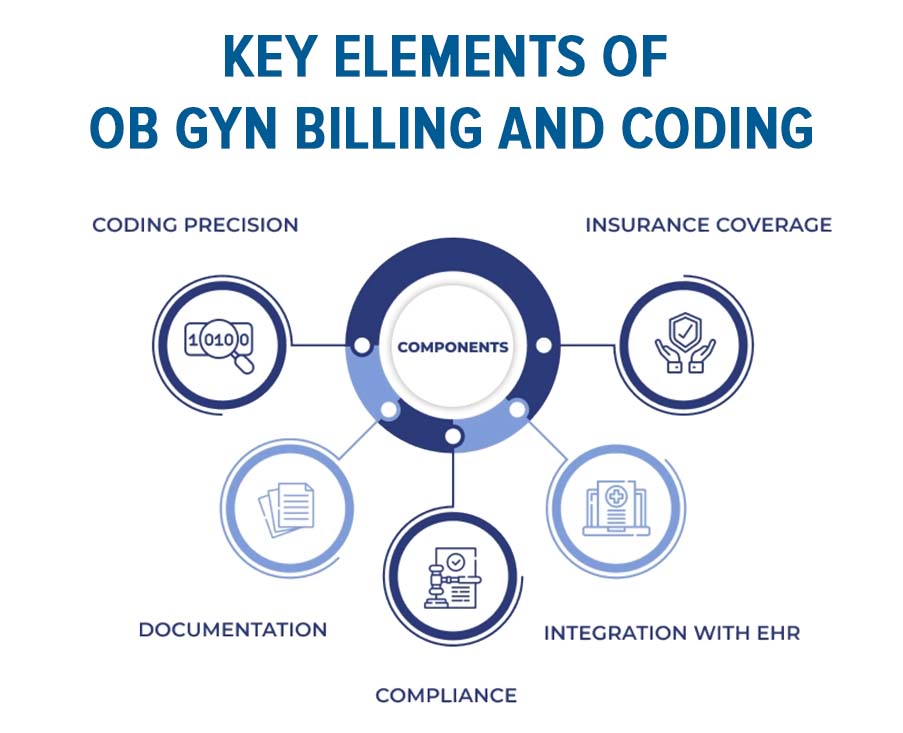
Optimizing OB GYN Billing And Coding Guidelines for Financial Health
In busy healthcare, precision is essential to efficiency. In OB/GYN, accurate billing and coding can be the difference between financial security and excellent patient care. The precision of OB GYN billing and coding is like composing a symphony of care. Services range from regular prenatal checkups to complex surgical treatments. However, Each note and medical treatment must be coded according to OB GYN billing and coding guidelines to ensure proper reimbursement and maintain the highest level of patient care.
OB/GYN services are unusual in that their breadth and complexity present coding challenges. In this complex system, each process, examination, and intervention needs its own precise coding to appropriately reflect the service provided. Codes aren’t just numbers—they’re essential for documenting and reimbursing all care.
In this complicated world of healthcare, where precision is key and the stakes are great, OB GYN billing and coding is more than paperwork. The goal is to trace each patient’s path, describe each service, and repay each claim.
Understanding OB GYN Billing and Coding
Understanding of medical billing and coding is important. This practice converts medical operations, diagnoses, and treatments into universal codes. This approach is more complicated in OB GYN due to the variety of services given.
OB GYN billing and coding is complicated by the wide range of services, from regular exams to obstetric ultrasounds and major surgeries. Coding for pregnancy phases, diagnostic tests, and gynecological therapies is complicated. Follow the recommendations to ensure correct compensation, avoid claim denials, and avoid compliance difficulties.
Practitioners must comprehend OB GYN coding protocols to succeed in this environment. Following these principles streamlines financial processes and ensures patients receive complete and accurate care.
Key Elements of OB GYN Billing and Coding

Obstetrics and Gynecology (OB GYN) includes many important women’s healthcare treatments. To achieve appropriate billing and reimbursement, these operations, from simple exams to complex surgery, require thorough coding.
Labor and Prenatal Care
Routine prenatal care, a cornerstone of OB GYN services, requires coding for each checkup, screening, and counseling session. Labor and delivery procedures, including monitoring and interventions, require correct coding.
Diagnostic and Gynecological Procedures
Ultrasounds, Pap tests, colposcopies, and biopsies are common in gynecology. Each step needs detailed criteria to code these tests accurately.
Surgical Procedures
OB GYN surgeries including cesarean sections and hysterectomies complicate classification. Each surgery needs precise coding to gather details and facilitate invoicing.
Specific Codes in OB GYN Billing
CPT Codes
ICD-10 Codes
ICD-10 codes give diagnoses and procedural justifications to supplement CPT codes. Accurate invoicing requires congruence between medical necessity and services performed.
HCPCS Codes
HCPCS codes are important for Medicare and Medicaid OB GYN services. These codes appropriately document and bill program-covered services.
Documentation Accuracy Matters
OB GYN billing and coding depend on precise documentation. Complete records support selected codes and demonstrate the need and amount of care. Comprehensive documentation improves patient care by facilitating provider communication and billing compliance.
Read More: What are the CPT Codes for Mental Health Billings? – 2024
Challenges In OB GYN billing and coding
- Practitioners struggle to code and bill OB GYN services due to their complexity. From simple checkups to complicated surgery, selecting the right codes needs finesse.
- Detail-oriented documentation complicates matters. Insufficient documentation might lead to inaccurate coding, affecting reimbursement and compliance.
- Keeping up with changing regulations is difficult. Regular billing and code adjustments require ongoing education and adaptation to avoid noncompliance.
- Claims denials and audits might result from coding errors caused by human error or misunderstanding requirements. These mistakes can cost a practice money and reputation.
Best Practices for OB GYN Billing and Coding
- Encourage thorough and precise documentation. Clear and detailed records support codes and justify care.
- Regular Education and Training
- Promote ongoing training for practitioners. Keeping up with coding changes and attending workshops or seminars helps ensure compliance.
- Use coding and billing software. Electronic health records (EHRs) or practice management systems help streamline and eliminate errors.
- Perform regular internal audits and reviews to spot and fix coding errors and compliance issues. This method ensures accuracy and reduces hazards.
- Promote communication among coding and billing workers. Clear communication and collaboration aid correct documentation and coding.
Reimbursement and Financial Impact
In OB GYN practices, accurate billing and coding affect reimbursement. Doctors are reimbursed for services that are properly documented and coded. Codes that accurately reflect services delivered speed up reimbursement and prevent denials.
Financial Impact of Errors or Noncompliance
Billing and coding errors can be costly. The practice loses revenue due to claim denials or delays due to inaccurate coding. Non-compliance with regulations can lead to penalties, fines, or legal action, affecting the practice’s finances and reputation.
Conclusion
OB GYN billing and coding require accuracy and compliance. OB-GYN billing and coding is complicated. From the variety of services requiring precise categorization to rigorous documentation, the complexities demand attention.
Practitioners provide fair reimbursement and better patient care by focusing precise billing and coding. A practice’s financial viability depends on its capacity to appropriately document and categorize services.
Thus, continual education, following norms, adopting best practices, and using technology will strengthen the practice’s financial base and improve patient care. Accurate billing and coding support OB GYN excellence and financial stability. Practitioners must prioritize these activities for the complete health of the practice and patients.
FAQs
These standards and principles help document and code Obstetrics and Gynecology procedures and services. They accurately depict medical services for billing and reimbursement.
Proper reimbursement, practice financial stability, and patient care depend on accurate billing and coding. They classify medical services for insurance claims and billing accuracy.
Services from routine checkups to sophisticated procedures require exact coding, making coding complicated. Compliance with changing regulations and adequate record keeping are also difficult.
Accurate coding helps healthcare providers document medical care and track patient progress. This improves medical team communication and provides prompt patient care.
Continuous education, coding updates, rigorous documentation, and best practices are essential. Training, technology, and audits ensure compliance.











